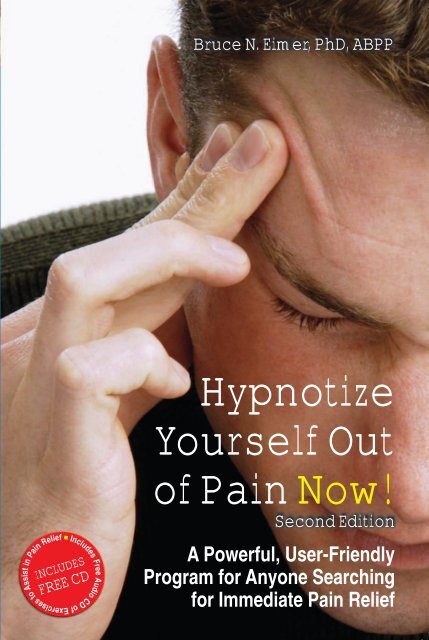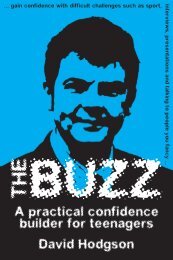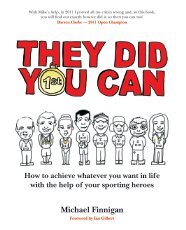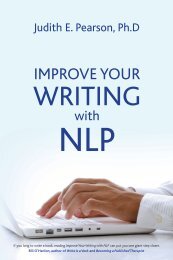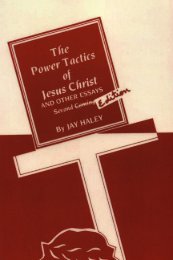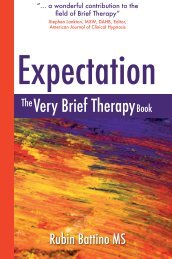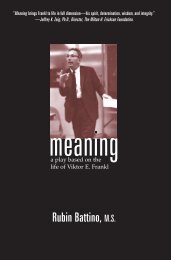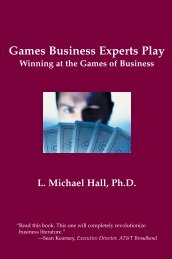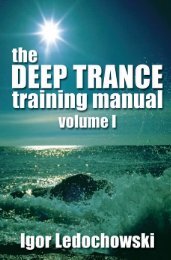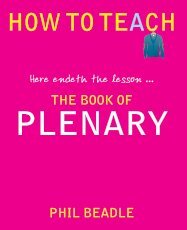Hypnotize Yourself Out of Pain Now!
Look Inside - Crown House Publishing.
Look Inside - Crown House Publishing.
You also want an ePaper? Increase the reach of your titles
YUMPU automatically turns print PDFs into web optimized ePapers that Google loves.
Bruce N. Eimer, PhD, ABPP<strong>Hypnotize</strong><strong>Yourself</strong> <strong>Out</strong>INCLUDESn Includes Free Audio CD <strong>of</strong> Exercises to Assist in <strong>Pain</strong> ReliefFREE CD<strong>of</strong> <strong>Pain</strong> <strong>Now</strong>!Second EditionA Powerful, User-FriendlyProgram for Anyone Searchingfor Immediate <strong>Pain</strong> Relief
<strong>Hypnotize</strong><strong>Yourself</strong> <strong>Out</strong> <strong>of</strong><strong>Pain</strong> <strong>Now</strong>!Second EditionA Powerful, User-FriendlyProgram for Anyone Searchingfor Immediate <strong>Pain</strong> ReliefBruce N. Eimer, PhD, ABPP
First published byCrown House Publishing LtdCrown Buildings, Bancyfelin, Carmarthen, Wales, SA33 5ND, UKwww.crownhouse.co.ukandCrown House Publishing Company LLC6 Trowbridge Drive, Suite 5, Bethel, CT 06801 USAwww.CHPUS.com© 2008 Bruce N. EimerThe right <strong>of</strong> Bruce N. Eimer to be identified as the author <strong>of</strong> this workhas been asserted by him in accordance with the Copyright, Designs andPatents Act 1988.First edition published by New Harbinger Publications, Inc. 2002(Original ISBN: 1572242809)All rights reserved. Except as permitted under current legislation no part<strong>of</strong> this work may be photocopied, stored in a retrieval system, published,performed in public, adapted, broadcast, transmitted, recorded orreproduced in any form or by any means, without the prior permission<strong>of</strong> the copyright owners. Enquiries should be addressed to Crown HousePublishing Limited.British Library <strong>of</strong> Cataloguing-in-Publication DataA catalogue entry for this book is available from the British Library.International Standard Book Number10 digit ISBN 184590087-113 digit ISBN 978-184590087-8Library <strong>of</strong> Congress Control Number2007938977Printed and bound in the UK
ContentsForewordAuthor’s Foreword to the Second EditionPrefaceAcknowledgmentsxixiiixviixxixPart OneLearn About Your <strong>Pain</strong> and How You Cope 1»»»»»»»»»»Understand the Puzzle <strong>of</strong> <strong>Pain</strong> 3Evaluate Your <strong>Pain</strong> and How You Cope 21Understand What Hypnosis Is and Isn’t 37Part TwoHow to <strong>Hypnotize</strong> <strong>Yourself</strong> <strong>Out</strong> <strong>of</strong> <strong>Pain</strong> <strong>Now</strong> 55Practice Inducing Self-Hypnosis 57Choose the Right Hypnotic Coping Strategy:Thinking and Behavioral Methods 79Choose the Right Hypnotic Coping Strategy:Distraction and Imagination Methods 107Change Your <strong>Pain</strong> Experience 143Solve Your Inner Conflicts about Your <strong>Pain</strong> 165Become AWARE and Find Your Inner Balance 195How to Select a Qualified Clinical Hypnosis Practitioner 201Recommended Further Reading 207References 211
Author’s Foreword to theSecond EditionSince the publication <strong>of</strong> the first edition <strong>of</strong> this book, very little haschanged in so far as the application <strong>of</strong> psychological and hypnotic techniques inthe management <strong>of</strong> chronic pain and persistent pain syndromes. Few doctorsand therapists have intensive training in this area. Many practitioners andpatients remain skeptical <strong>of</strong> the value <strong>of</strong> hypnosis, self-hypnosis training andpsychological techniques for relieving persistent pain and suffering. Peoplegenerally turn first to drug interventions and medical/surgical procedures asthese are what are reimbursed by health insurance companies.Nevertheless, when all else has failed, many people who continue tosuffer from persistent pain that has not responded to the gamut <strong>of</strong> medicaltreatments turn to alternative treatments such as acupuncture, hypnosis,imagery, psychotherapy, therapeutic touch, massage therapies, energytherapies, herbal remedies, etc.I wrote this book to fill a gap in the self-help literature by providing aguide to using hypnosis, self-hypnosis and imagery techniques for managingchronic pain. I have used all <strong>of</strong> the techniques described in these pages inmy practice with patients. Clearly, not all techniques work for everyone,but almost always I have found that there is a hypnotic technique foreveryone or someone. In clinical practice, we assess the patient and explorewhich techniques have the greatest efficacy. The good thing is that, withpsychological and hypnotic therapies, there is no significant downsideissue <strong>of</strong> risks <strong>of</strong> negative side effects as there frequently are with drugs andsurgery.As the reader <strong>of</strong> this book, you will have the opportunity <strong>of</strong> exploringa wide range <strong>of</strong> hypnotic and self-hypnosis techniques for helping you toimprove your ability to cope with and manage discomfort so that you can
xiv<strong>Hypnotize</strong> <strong>Yourself</strong> <strong>Out</strong> Of <strong>Pain</strong> <strong>Now</strong>!live more comfortably. It is my suggestion that you read the entire book.However, how you go through it is your choice.You may wish to read it cover to cover first and then go back to specificsections, or you may wish to read certain sections that appear to have themost relevance to yourself at this point in time. However you choose to gothrough the material in this book is fine, and I am confident that you will finda way <strong>of</strong> doing so that will work for you.I myself, being a person with chronic pain, also use many <strong>of</strong> thetechniques in this book to maintain and promote greater physical andemotional comfort for myself. In fact, I have been doing so for quite sometime. The techniques have been presented so that you can work with theexercises on your own, or with a knowledgeable therapist or coach, if one isavailable to you.Of course, please understand that the material in this book is presentedfor educational purposes only, as it is impossible and unethical to diagnoseor treat physical illnesses or mental, emotional or psychological disordersthrough a book!Please be advised that any new unexplained pain, or change in yourpain symptoms should be reported to a licensed medical physician. Itis irresponsible to attempt to mask pain symptoms that could be a signal<strong>of</strong> a medical condition that needs to be treated. Remember that pain is asignal that something is wrong that needs to be addressed. When everythingmedical has been done that should be done and can be done, then, it is timeto explore psychological methods <strong>of</strong> coping.This does not mean that you should not use good psychological copingtools in the acute phases <strong>of</strong> a painful condition. I am saying that the firstthing to do is to get proper medical treatment. However, unfortunately,<strong>of</strong>ten medical treatments can only do so much, and you might be left tolive with bothersome symptoms, or be forced to make hard choices. Thisis when many <strong>of</strong> the techniques described in this book can really be helpful.Knowledge is power, and this book will impart knowledge to empower you.Ultimately, we all must help ourselves. Self-help requires knowledge,timely and accurate information, and a positive attitude. These all figure intothe process <strong>of</strong> developing the skills that are necessary for effective coping.In this second edition <strong>of</strong> this book, we have added an additionalcomponent. This is a 45 minute audio hypnosis CD. This CD contains
xvi<strong>Hypnotize</strong> <strong>Yourself</strong> <strong>Out</strong> Of <strong>Pain</strong> <strong>Now</strong>!• <strong>Pain</strong> relief and comfort imagery exercises• Healing imagery• Therapeutic touch and energy healing• Comfort transfer techniques• Instant stress controlThe hypnotic and relaxation techniques on the CD are all described indetail in print in this book. So, please continue reading, listen to the CD atany point when you feel like doing so and it is appropriate to do so, and startgetting more comfortable. I wish you peace and comfort and healing.Bruce N. Eimer, Ph.D.September 18, 2007
SIXChoose the Right HypnoticCoping Strategy: Distractionand Imagination MethodsOne can always forget pain.—Milton H. Erickson, M.D. Distraction: The Fourth DDistraction refers to diverting or redirecting your attention awayfrom one thing toward another; for example, away from pain and towardsomething neutral, pleasant, or less uncomfortable.Distraction is an effective pain-control strategy because the consciousmind can only process a finite or limited amount <strong>of</strong> input and informationat one time. The unconscious, on the other hand, can process many things atthe same time. So the goal in using the strategy <strong>of</strong> distraction is to introducestimuli and sensations that compete with the pain sensations for yourconscious attention. If these competing sensations get to your brain first,they can prevent the pain sensations from ever reaching your brain. Theycan at the least slow down the transmission <strong>of</strong> the pain sensations up yourspinal cord.Distraction Works from the Bottom UpWhen your conscious mind is paying attention to the sensationscreated by your rubbing or massaging the area <strong>of</strong> your body that hurts, it hasless capacity to pay attention to pain sensations. Recall from our discussion
110 <strong>Hypnotize</strong> <strong>Yourself</strong> <strong>Out</strong> Of <strong>Pain</strong> <strong>Now</strong>!<strong>of</strong> the neurology <strong>of</strong> pain in chapter 1 that the nerve fibers that transmitsensations <strong>of</strong> pressure, touch, and vibration carry information to the brainfaster than those nerve fibers that transmit pain sensations. So, when thefaster fibers are fired up through the introduction <strong>of</strong> tactile-kinestheticstimulation such as touch, pressure, rubbing, or massage to the area <strong>of</strong>discomfort, their sensory signals get to the brain before the pain messagesdo. This tends to close the pain gate in the spinal cord.Similarly, when your conscious mind is deeply absorbed in othertactile-kinesthetic activities such as paying attention to your breathing,enjoying the beach, writing, or painting, it cannot pay as much attention topain. This also closes the pain gate.Distraction is probably the easiest and simplest pain-coping strategy.It also capitalizes on the fact that what is most important at any givenmoment is what tends to capture your conscious attention. For example, ifyou were thinking about your pain and suddenly you heard a series <strong>of</strong> loudbooms signalling the beginning <strong>of</strong> a thunderstorm, you would be likely t<strong>of</strong>orget about your pain temporarily if you had forgotten to close the windowson your sun porch. You would most likely be redirecting your immediateattention to getting those windows closed before the porch got soaked!In sum, distraction works by introducing stimulation that competeswith the pain in your nervous system. The distractors generate competingnerve signals that beat the pain to the brain. They get there first and closethe gate on pain.Case example. The following example illustrates the mind-body-painconnection. When I take a walk, I usually get a deep gnawing pain in themuscles <strong>of</strong> my lower back. At the end <strong>of</strong> my walk, sometimes that pain isalmost biting in its intensity. The application <strong>of</strong> ice usually helps to alleviatethe pain by numbing the area, but little else helps. While I’m walking, if thepain gets really bad, my posture is affected. The pain causes my spine andback to list or tilt to one side. If I’m tired, and I don’t have enough energy tocompensate posturally for that tilt, this bows me over even more and furtherincreases the pain.One thing I discovered that helps is when I have a walking partner. IfI become pleasantly distracted in conversation, I am temporarily less aware<strong>of</strong> the pain. Somehow or other, when I am less aware consciously <strong>of</strong> the pain,my spine does not seem to list quite as much. In this case, when the walk isover, I’m usually in not quite as much pain.
158 <strong>Hypnotize</strong> <strong>Yourself</strong> <strong>Out</strong> Of <strong>Pain</strong> <strong>Now</strong>! Self-Suggestions to Promote Self-HealingThe following eight self-suggestions for empowering your unconsciousmind and your self-healing are adapted from Mutter (1987). For maximumeffectiveness, choose up to four to give yourself before entering self-hypnosis.Work with the self-suggestions you have chosen for at least several days.Then, if you wish, you can switch to another set <strong>of</strong> self-suggestions.1. I have survived despite all I’ve gone through; therefore, all <strong>of</strong> thepowers that have gotten me through to this point are still with me.2. Should I have a flare-up, my mind will immediately remember to useone or more fitting hypnotic coping techniques to promote my selfhealing.3. Should I have a bad dream, a flashback, or a flare-up, my mind willimmediately remember that I have survived and that I will continue toimprove.4. Because my unconscious has a sacred trust to protect me, it will causecertain healthful changes in my body by allowing me to turn, move,twist, or bend, but only within my physical capacity and not beyondit.5. I feel greater comfort and I stay within those limits and protect thatcomfort for prolonged periods <strong>of</strong> time.6. As I continue to heal, I am able to move, turn, twist, and bend to agreater degree, but only within my physical capacity and not beyondit.7. As I continue to enjoy my greater comfort, I need not fear going beyondmy physical capacity and re-injuring myself.8. By continuing to practice my self-hypnosis, I help myself to heal.And here are some additional suggestions to explore.9. My body and mind work together to strengthen my healing powers.10. My body knows what to do to send healing energy to where it’sneeded most.11. I deserve to be comfortable.
Change Your <strong>Pain</strong> Experience 15912. I have faith in my body’s healing power.13. Every day in every way I am getting better and better.14. I am on safe and solid ground.15. I accept myself fully and completely.16. I am free <strong>of</strong> old, outdated childhood needs.17. I am filled with positive energy.18. Making mistakes and then correcting them positively increasesmy energy and my comfort and diminishes my discomfort.19. Making mistakes and then correcting them releases and makesavailable more <strong>of</strong> my healing power to wherever it is neededmost.Exercise 7.3: The Mindfulness MeditationSelf-Hypnosis MethodMindfulness meditation has evolved out <strong>of</strong> the Zen Buddhist meditationtradition, and the present-day work <strong>of</strong> people such as Jon Kabat-Zinn (Kabat-Zinn 1995) and Herbert Benson (Benson 1997). The main idea is to concentrateon an idea or object and stay with it. That is what we were doing with themarble method and the attention to breathing methods.This particular self-hypnosis method involves concentrated attention, too, butit adds another element. The object <strong>of</strong> attention is a self-suggestion, image,word, or sound that has special, positive meaning and significance and isassociated with healing. Here are the steps:1. Sit comfortably with your feet flat on the floor, you head, neck,and back supported, and your hands resting lightly, palms-downon your thighs.2. Select a self-suggestion, image, word, or sound that has specialmeaning and significance to you. If you choose an image, word,or sound, it should be one that you associate with healing. Thiswill serve as your mantra or object <strong>of</strong> concentration. Somepotential images to choose from are: a candle flame, oceanwaves, the surface <strong>of</strong> a mountain lake, forest pond, or stream,a river, the desert, the setting sun, a tree or plant, a garden, ananimal, a crystal ball, or falling snow. There are many others. Somepotential sounds to choose from are: the sound <strong>of</strong> ocean waves, a
160 <strong>Hypnotize</strong> <strong>Yourself</strong> <strong>Out</strong> Of <strong>Pain</strong> <strong>Now</strong>!running stream, a waterfall, the sounds <strong>of</strong> the forest on a summernight, a summer rain shower, chirping crickets, birds singing,or melodious singing or music. You now have the resources tochoose a word or self-suggestion that meets your inner needs.3. <strong>Now</strong> close your eyes, breathe naturally, and begin to pay attentionto your breathing without trying to change your breathing.4. As you continue to pay attention to your breathing, also beginto pay attention to your chosen self-suggestion, word, image, orsound. You can tie it to your breathing or not. If you choose to tieit to your breathing, continue to pay attention to your breathing,and silently say and hear, or visualize and see, your mantra orimage each time you exhale. If you choose not to tie your mantraor image to your breathing, then just hear it or see it in the waythat your unconscious presents it to you. As soon as you realizeyour mind has wandered, and you’re no longer hearing or seeingyour mantra or image, refocus your attention back to hearing orseeing it, whichever the case may be.5. When you are ready to awaken, count silently from one to five,and at five, blink your eyes, open them wide, and feel comfortable,wide awake, and yet relaxed at the same time. Your comfort willlast for some time after you have completed this exercise andawakened.Exercise 7.4: The Projection Self-HypnosisMethodThis step-by-step method combines several steps from previous techniqueswe have covered.1. Sit comfortably with your feet flat on the floor, your head, neck,and back supported, and your hands resting lightly, palms-downon your thighs.2. <strong>Now</strong> focus your visual attention on anything that literally canserve as a “projection screen”; for example, a crystal ball, a clearglass or crystal bowl filled with water, or a blank, white sheet <strong>of</strong>paper. Stare at your projection screen while you breathe normallyand pay attention to your breathing without trying to changeyour breathing.3. As you continue to stare at your projection screen, allow yourunconscious to bring to your conscious attention a dynamicimage <strong>of</strong> an experience that it associates with pain relief andcomfort. See this pain relief image in the projection screen.
… to tame pain, we must use our brainThe use <strong>of</strong> hypnosis as a tool for relieving pain is not experimental—it is tried, tested, and proven. This book focuses on your role in being yourown healer. It will help you explore a wide range <strong>of</strong> self-hypnosis techniques,improving your ability to cope with and manage your pain and allowing youto live more comfortably.You will learn how ton Use self-hypnosis to relieve your painn Tap into your own innate ability to control painn Choose the method <strong>of</strong> self-hypnosis best suited to youn Interrupt your body’s chronic pain loopn Use a variety <strong>of</strong> powerful tools to reduce or eliminate your pain“ Those who suffer chronic pain have <strong>of</strong>ten spent a long time trying medical and alternativeapproaches without finding relief and, under such circumstances, it is understandable to lose hopeand the motivation to keep trying new methods. If this describes you, take heart - reading this bookwill really make a difference for you and will help you regain control <strong>of</strong> your mind and body. … themost comprehensive and effective program for lasting pain relief that I have ever found.”Susanna Bellini, NLP trainer, counsellor, hypnotherapist and also a chronic pain survivor“ Full <strong>of</strong> valuable information and empowering methods easily understood and practiced withoutany additional training, <strong>Hypnotize</strong> <strong>Yourself</strong> <strong>Out</strong> <strong>of</strong> <strong>Pain</strong> <strong>Now</strong>! provides the keys that can unlocksolutions to even the most stubborn pain problems. It’s hard to imagine a better resource on the use<strong>of</strong> hypnosis with pain conditions. ”Maggie Phillips, PhD, author <strong>of</strong> Reversing Chronic <strong>Pain</strong>,Finding the Energy to Heal, and Healing the Divided Self“ … questionnaires in the book allow the reader to measure their experience <strong>of</strong> pain and how thatchanges as they make progress. This makes it almost a workbook rather than simply a theoreticaltext on the subject. … an impressive work, accessible and clearly written.”Stuart Harragan, Clinical Hypnotherapist“ With a number <strong>of</strong> powerful methods to reduce or eliminate discomfort and a free CD <strong>of</strong> exercisesto assist in pain relief, this great value book and CD set will help anyone who is suffering to tap intotheir own innate ability to control and manage pain.”Stephen Gawtry, Editor, The Watkins Review“… valuable and thought-provoking for people experiencing chronic pain. Eimer approaches hissubject with the first-hand knowledge and commitment <strong>of</strong> someone who, after an accident, soughtrelief from the resulting persistent pain.”Anthony Scratchley, Addiction Today MagazineBruce N. Eimer, PhD, ABPP, is a clinical psychologist in Philadelphia with over twenty year’s experiencetreating people with chronic pain using cognitive-behavioral and hypnosis strategies and is certified bythe American Society <strong>of</strong> Clinical Hypnosis as an Approved Consultant in Clinical Hypnosis. He is achronic pain survivor and has used self-hypnosis techniques to manage his pain.Family and Health/<strong>Pain</strong> ManagementUK £12.99 US $24.95ISBN 978-184590087-85 2 4 9 5Crown House Publishing Limitedwww.crownhouse.co.uk – www.chpus.com9 781 845 900878


